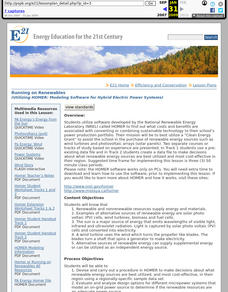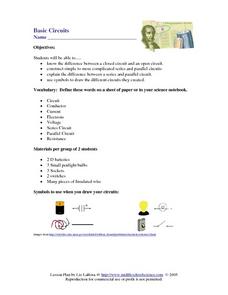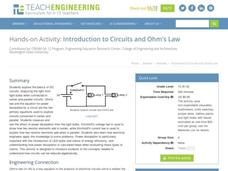Curated OER
Powered Up About Electricity!
Students study the process of turning coal into electricity. In this electricity lesson, students are guided by their teacher through the steps required to turn coal into electricity. Students complete a worksheet answering questions...
Curated OER
Electricity: Going with the Flow!
Fifth graders explore a simple circuit. They experiment with a wire, light bulb and a bettery to see how many ways they can make the light bulb light up. Students describe how they were or were not ablt to light the bulb.
Curated OER
Simply Circuitry and Series Circuit
Students investigate a series circuit. In this physical science lesson, students use a battery, switch, and light bulbs to build an electrical circuit. Students identify the standard symbols being used in electric circuitry.
Curated OER
Stepper Motor
Students compare a stepper motor from a traditional motor. In this physics lesson, students summarize how it works. They build their own stepper motor and explore its uses.
Curated OER
What's a Resistor?
Learners determine what a resistor does as they construct parallel circuits. In this circuitry lesson, students experiment with batteries, alligator clips, a resistor and a three-way switch to find out what a resistor does. They continue...
Curated OER
Build a Simple Motor?
Learners experience how to construct a simple electromagnet based motor. In groups they explore what a component is and construct a circuit that can rotate the orientation of the magnet by turning the switch on and off. Electromagnetic...
Curated OER
Running on Renewables
Students investigate the costs and benefits of switching their school to sustainable technology energy production. They use software called HOMER developed by the National Renewable Energy Lab to do the cost/ benefit analysis. They then...
Curated OER
Applied Science- Physics
Students investigate how something at home uses physics to work. In this practical physics lesson, students develop a theory of their own to conclude how an object might work. This lesson plan includes a worksheet.
Curated OER
One Path
Students discover that charge movement through a circuit depends on the resistance and arrangement of the circuit components. In a hands-on activity, students build and investigate the characteristics of series circuits. In another...
Perkins School for the Blind
Building a Basic Series Circuit
Make science a fully accessible subject for your learners with visual impairments. They'll use tactile models to explore the nature of basic electrical circuits. Template board, wires, batteries, and Velcro are used to construct the...
Curated OER
Resistance In Series And Parallel Circuits
Students investigate electric circuits. In this electricity instructional activity, students observe illumination in a series and parallel circuits. They predict and calculate the resistance in each type of circuit using a voltmeter.
Curated OER
Mystery Card 1
Students test their knowledge of electrical conductors and circuits by constructing an electric tester and using it to determine where electricity flows between circles on a mystery card.
Curated OER
Mystery Card 2
Students make a circuit on a mystery card. They then use an electrical tester to determine where electricity flows between circles on the card. They will connect wires, bulbs, and a battery to form an electrical tester.
Curated OER
Mystery Card 3
Young scholars will make a circuit on a mystery card. They will connect wires, bulbs, and battery to form an electrical tester. After students learn how to make one following the directions, they can create their own mystery card by...
Curated OER
Watts Up with the Heat
Students create a variety of simple, series and parallel electrical circuits to illustrate how electricity flows through different types of basic circuits.
Curated OER
Build a Simple Circuit
Students construct an extremely simple series circuit that powers a lamp on and off with a switch. They are in groups of 4 and are given a set of components and have to build the circuit working together as a group. Finally, they have to...
Curated OER
Electricity/Magnetism
Second graders experiment with ballons to see which objects will cling and which objects will not. They use an assortment of objects, paper clips, pennies, button, scraps of paper, or puffed cereal. They make predictions and record results.
Curated OER
Electrical Circuits And Switches
Students design and draw circuits with batteries, small light bulbs and common household conductors. They build and test the circuit then modify it so someone who couldn't use their hands could turn the circuit on and off.
Curated OER
Microbiology Lab Safety
In this biology worksheet, learners are introduced to the practices of safety as related to using a laboratory and then answer some questions as an assessment.
Starry Night Education
The Stars
Three astronomy activities in one resource! Here you will find one hands-on activity, one demonstration, both with discussion questions, and one activity worksheet. During these lessons young scientists discuss how stars are...
Curated OER
Basic Circuits
Students explain the difference between a closed circuit and an open circuit. They construct simple to more complicated series and parallel circuits. They explain the difference between a series and parallel circuit.
Curated OER
Elaine Humphrey, Gwynne Thompson
Second graders become familiar with the parts of the microscope and how it works. For this microscope lesson, 2nd graders experiment with different light and settings. Students answer questions based on their experiment.
Curated OER
Circuit City
Fifth graders are introduced to the concept of circuits and how electricity works. In groups, they design their own subdivision with houses in which they have inside and outside light sources. To end the instructional activity, they...
Teach Engineering
Introduction to Circuits and Ohm's Law
Take a very basic understanding of circuits and develop a strong understanding of the parts and function of a circuit. This activity is developed to be an independent exploration of circuits from the basics to series and parallel models....

























